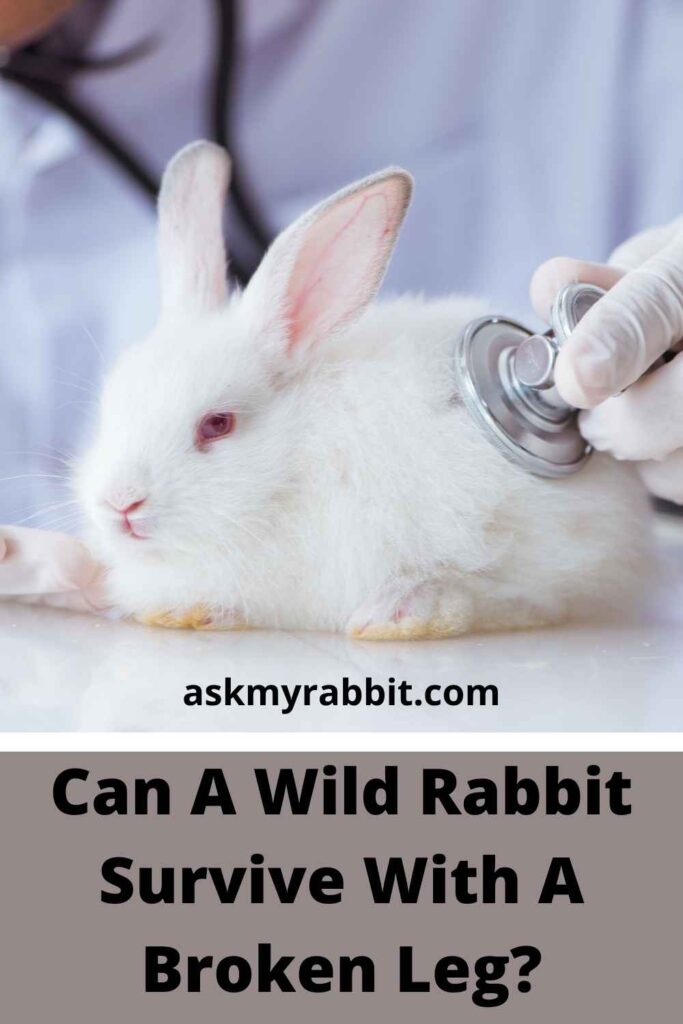Rabbits are wonderful pets who have distinct personalities and affectionate temperament. Due to this, they soon become part of the family. It is consequently very difficult when they are wounded or ill. A fractured leg is a particularly tough injury to cope with.
Yes, rabbits can live with a broken leg if they receive proper attention and treatment in time. Rabbits are nimble animals. They’re built to jump and leap. They feel safe knowing they can get away from predators swiftly.
A rabbit’s limbs are what keep them mobile and joyful. Rabbits, on the other hand, have unusually delicate bones. This makes them more prone to fracturing.
Rabbits are unable to show these normal behaviors when they break a leg. As a consequence, they might feel highly anxious. Broken limbs are not only stressful, but they are also excruciatingly painful.
Stress and discomfort in rabbits may be particularly problematic since they can lead to a variety of health problems. This may include gastrointestinal stasis which can be lethal if not addressed.
In this article, we will inform you all about caring for your rabbit with a broken leg. So, keep reading!

Can A Rabbit Die From A Broken Leg?
Yes, a rabbit may die from a broken leg if not treated properly. A fractured bone may be more difficult than it seems on the surface. Broken bones can mend, but it’s the complications that come with them that cause the most problems. The extent of the damage has a significant impact on the rabbit’s prognosis.
Shock, internal hemorrhage, and even paralysis may occur in rabbits. You should also consider what would happen if the broken bone protruded from the skin. When a bone breaks, things don’t always go as planned. The consequences of a broken leg may often be worse than the broken leg itself.
There’s also a danger that the bone may not heal properly. If broken bones are correctly positioned and corrected, they will heal normally. It’s possible that the shattered component of the bone will grow back at an angle if it’s off-centered.
There is always a chance of chronic pain, strain, or discomfort while moving. This depends on how your bunny recovers.
You must also consider the danger of infection, which may spell the death for the rabbit. Domesticated rabbits have access to medication and antibiotics, whereas wild rabbits do not.
Can A Wild Rabbit Survive With A Broken Leg?

While a fractured leg isn’t always fatal, it is important to consider the severity of the damage. To avoid perilous circumstances, a rabbit needs its legs. Rabbits are normally considered prey in the wild. A broken leg may significantly reduce their chances of survival.
No, a wild rabbit cannot survive with a broken leg. Rabbits, like most other prey animals, depend significantly on their legs to acquire food and avoid danger. A rabbit’s chances of surviving in the wild are greatly reduced if its leg is damaged.
Even if rabbits were in excellent condition and had no injuries, survival in the wild is difficult. Even if it is just for a short time, losing the use of a significant limb will make every day a challenge. They’d be easy prey for any animal looking for a fast slaughter.
To be honest, its capacity to survive would be mostly determined by the environment and all of the predators that surround it. The wild rabbit has a better chance of recuperating and ultimately leading a normal life if it lives in an area with few or no predators.
If the rabbit lives in an area with owls, hawks, eagles, falcons, wild dogs, feral cats, and ground squirrels, it would starve or be killed.
How Can A Rabbit Break Its Leg?

A rabbit’s fractured leg may be caused by a variety of factors. A rabbit may break it’s leg if it is dropped while being handled. Also, if they fall awkwardly while attempting to leap down from a high place, its leg might be fractured.
Rabbits’ legs may also get stuck between cage bars with insufficient width spacing. If they attempt to extricate themselves, they may break their leg.
If your rabbit’s leg has been fractured or broken, it may suddenly begin to limp. Although this is an evident cause of limping in rabbits, it is also a significant one.
Rabbits may leap off of high places or out of your arms while you’re holding them, breaking their legs if they fall too hard on their legs. When tiny children attempt to carry pet bunnies, this is a regular occurrence.
A broken leg might result by the rabbit struggling and falling or jumping and landing awkwardly. If you fear your rabbit has broken a leg, take it to a veterinarian as soon as possible.
A fracture might also develop if your rabbit’s leg gets caught in anything, such as its cage bars. Improperly sized cage bar spacing, as well as ramps in their cages and floor vents in your house, are common causes. Check to see whether your rabbit’s leg can fit into or through any of the things in their surroundings.
What Are The Symptoms Of A Rabbit With Broken Leg?
A rabbit’s bones are frail. Therefore, when they break, they may shatter. This may make mending more difficult.
The first symptom of a broken leg in a rabbit is when they begin to limp. The other symptoms of a rabbit with broken leg is:
- Stooped posture
- Shallow breathing
- Lethargy
- Unwillingness to move at all
Can A Rabbit’s Broken Leg Heal On Its Own?
No, a rabbit’s broken leg cannot heal on its own. Although broken bones are painful, the majority of them recover quickly.
The healing depends on stem cells, as well as bone’s intrinsic propensity to regenerate. The bone heals by forming cartilage to fill in the gap left by the break. The old bone is then replaced with fresh bone.
What To Do If You Suspect That Your Rabbit May Have Broken Its Leg?
If you suspect your rabbit has broken a leg, you should take them to your veterinarian as soon as possible. It’s probable that your rabbit has a fractured leg if they’re hobbling or not moving about normally.
Broken legs are very painful, and your rabbit will need pain medication from your veterinarian. This will make them feel better and help them from getting additional health problems like gastrointestinal stasis.
After stabilising your rabbit and controlling their discomfort, your veterinary surgeon will be able to discuss treatment with you. This involves taking x-rays to get a better look at the fractured leg. Following these tests, your veterinary surgeon will be able to tell you how serious the injury is and what treatment options are available.
How Long Does It Take For A Rabbit Broken Leg To Heal?
The fracture in your bunny’s leg might take up to two months to heal. It is necessary for your bunny to rest and use the leg lightly during this period in order for the fracture to heal. He can walk on it easily with the splint, which is a vital component of the healing process.
Due to the splint’s efficiency, the bone has less of a propensity to recover when the leg isn’t used minimally. If the wound does not heal, surgery may be required.
What Are The Options For Treating A Broken Leg In Rabbits?

The following are the most popular ways to treat a broken leg in rabbits:
1. Surgical Intervention
A veterinary surgeon must operate on the rabbit’s leg in order to maintain the fractured leg in place. To keep the fragmented bone parts together, surgeons often use a mix of surgical pins, plates, and screws in the leg.
In surgery, the fractured limb is stabilized. However, your rabbit will require rest and rehabilitation. Your rabbit will need to be confined to a small location with restricted mobility for an extended length of time.
This may take several weeks, to avoid the fragments of bone that have been cemented in place from migrating. Rabbits may get quite anxious in these situations. This may lead to additional health issues.
After a surgical repair of a fracture, infection in the leg is a possibility. This may happen particularly if the fracture is an open fracture, where the bone has broken through the skin.
2. Treatment Without Surgery
In this treatment, the veterinary surgeon will use bandaging materials and splints to hold the rabbit’s leg in position. The shattered bones will be kept in line so that they can mend.
However, not all fractures, especially those in rabbits’ rear limbs, can be repaired this manner. Your veterinary surgeon will review the sort of fracture your rabbit has and if this is an appropriate treatment option with you.
In this treatment, your rabbit will need to be confined to a small area with restricted mobility for a long time. This may usually take several weeks. Rabbits may get quite anxious in these situations, which can lead to additional health issues.
3. Amputation
The veterinary surgeon will amputate the fractured leg during this procedure. This method is not suitable for all rabbits. The rabbit must be capable of adapting to life on three legs.
Amputations are not recommended for rabbits with underlying problems like as arthritis or obesity. This is because they are less likely to adapt well without a limb.
This treatment has a shorter recovery time since the fractured limb is removed and does not need to be repaired. Nevertheless, some recovery time will be required for the surgical incision.
Amputation in rabbits has been linked to a high rate of long-term problems, according to studies. Due to the change in movement and strain on other limbs, this might cause pododermatitis. This can be harmful to your bunny’s health.
What Does Fixing A Rabbit’s Broken Leg Cost?
Fixing a rabbit’s broken leg may cost a lot of money. The cost of setting the leg would range from $500 to $1500.
This also depends on the number of x-rays required. If surgery is required in order to fix the leg, it may cost more.
How Do I Treat A Rabbit’s Broken Leg At Home?
If you notice that your rabbit has an injured leg at home, get medical attention as soon as possible. Wrap a towel around the rabbit. Avoid attempting to wrap or splint the rabbit’s leg.
Instead, wrap your rabbit carefully on a clean towel and place it in its carrier. While you call the doctor, try to keep the rabbit quiet and comfortable. Hold the rabbit with care and speak to it in a low, calming tone. Do not attempt to wrap the limb as it may give your rabbit discomfort or aggravate the damage.
A limb fracture may be present if your rabbit seems to be in discomfort or your rabbit is limping. Fast breathing, unwillingness to eat or a lack of interest in its surroundings are all signs that your rabbit is in discomfort.
Before you take your rabbit to the doctor for medical care, make your bunny as comfortable as possible. The wound will most likely be cleaned, treated, and bandaged by the veterinarian. Your rabbit will very certainly need surgery.
Once you’ve returned home with your rabbit, make sure it receives the rest it needs to mend properly. It’s also a good idea to understand how to avoid fractures in the first place.
Frequently Asked Questions
What Do You Do With A Wild Rabbit With A Broken Leg?
If it’s an injured wild rabbit, call a wildlife rehabilitation center. You may also contact your local Humane Society to see if they offer a Wildlife Center.
How Fast Do Rabbits Heal?
Adhesions and normal tissue healing begin to develop in rabbits within twenty-four hours following surgery. Within a few days following surgery, a rabbit will typically able to resume routine activities.
Can Rabbits Dislocate Their Legs?
Yes, it is possible for rabbits to dislocate their legs. Rabbits’ hind legs are normally quite powerful, and they use them to hop. In rabbits, vertebral fracture or dislocation is a frequent cause of hind limb weakness and paralysis.
Final Words
Mobility is the most important consideration while treating a broken leg. It’s critical to restrict the bunny from shifting the leg by stabilizing it as much as possible. Your bunny may have to spend six to eight weeks in a carrying cage until her leg heals.
Your rabbit may face various health difficulties as a result of being immobile for such a long time. Keep a close eye on her food, drink, and hay consumption. Make sure that she is comfortable in her cage and rests properly.
We hope this article has provided you with all the information you require on treating bunny’s with a fracture in the leg. If you have anymore questions, drop them in the comment section below.






